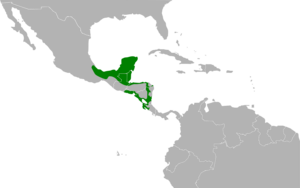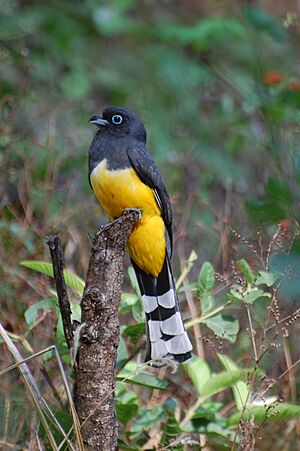Black-headed trogon facts for kids
Quick facts for kids Black-headed trogon |
|
|---|---|
 |
|
| Near Tulum, Mexico | |
| Conservation status | |
| Scientific classification | |
| Genus: |
Trogon
|
| Species: |
melanocephalus
|
 |
|
The black-headed trogon (Trogon melanocephalus) is a colorful bird that lives in Central America. It belongs to the Trogonidae family, known for their bright feathers. You can find this bird in countries like Mexico, Belize, Costa Rica, and Honduras.
Contents
About the Black-headed Trogon
Birds are grouped by scientists to understand them better. The black-headed trogon is a special type of bird in the trogon family. Most experts agree that it's just one unique species, not divided into smaller groups.
What Does It Look Like?
The black-headed trogon is about 27 to 28 centimeters (11 inches) long. It weighs around 74 to 95 grams (2.6 to 3.4 ounces). Both male and female adults have a dark, slate-black head, neck, and chest.
They have a bright sky-blue ring of skin around their dark eyes. A thin white line separates their dark chest from their bright yellow belly. This yellow color gets lighter near their tail.
Their two inner tail feathers are a shiny bronze-green or bluish-green with black tips. The next pair of feathers are all black. The three outermost pairs are black with wide white tips. Their wings are slate black with some white parts.
Male adults have bright, shiny bluish-green or golden-green upper parts. Their lower back and upper tail feathers are metallic blue or bluish-violet. Female adults have dark slate-colored upper parts instead of the male's metallic colors.
Young males have mostly black tails with only a little white. Their wings also have more white than adult males. Young females' inner tail feathers do not have black tips. Like young males, their tails have less white than adult females.
Where Does It Live?
The black-headed trogon lives in many parts of Central America. You can find it on the Caribbean side of Mexico, through Belize, northern Guatemala, and northern Honduras. It also lives in central Nicaragua.
On the Pacific side, it is found from El Salvador through southern Honduras and western Nicaragua. It also lives in northwestern Costa Rica.
This bird likes many kinds of forests. These include wet tropical forests, pine forests, and forests along rivers. It also lives in forests that are growing back and dry forests.
It prefers the edges of forests rather than the deep, dense parts. You can also see it in open areas like banana and cacao farms, gardens, and even in towns. It usually lives from sea level up to 600 meters (2,000 feet) high. Sometimes, it can be found as high as 1,000 meters (3,300 feet).
How Does It Behave?
Movement
The black-headed trogon does not migrate. This means it stays in the same area all year round.
Social Behavior
These birds often gather in groups of up to 12 individuals. These groups usually have more males than females. Scientists think this might be a type of gathering where males show off to attract females.
What It Eats
The black-headed trogon usually looks for food in the middle or top parts of trees. It often hunts along forest edges and in open spots. Adult birds eat fruits and insects. They fly out from a perch, grab their food while hovering, and then return to the perch to eat. Young birds are fed mostly insects, especially insect larvae.
Breeding and Nests
The breeding season for the black-headed trogon changes depending on the area. It seems to be between March and July. All known nests have been found inside active termite nests.
Both male and female birds dig out the nest cavity. They might dig from the bottom of the termite nest or horizontally into its side. Nests have been found from near the ground up to 5 meters (16 feet) high.
They usually lay three eggs. Both parents sit on the eggs for about 17 to 19 days. The young birds leave the nest about 16 or 17 days after hatching.
What It Sounds Like
The black-headed trogon is a vocal bird, so you can often hear its calls. Its most common call is a loud series of 15 to 20 fast "cluck" or "cuck" notes. Sometimes, a pair of birds will sing this call together. Small groups of birds also sing it. Their alarm call is a single, low "cuck" sound.
Status of the Black-headed Trogon
The IUCN (International Union for Conservation of Nature) says the black-headed trogon is a species of "Least Concern." This means it is not currently in danger of disappearing. It lives in a large area, but its exact population size is unknown. Scientists believe its numbers might be slowly decreasing.
No immediate threats to the species have been found. It is common in most places where it lives. This bird is also more adaptable than other trogons. It can live in forests that have been changed by humans. It can even live in areas like pastures, farms, and plantations.



